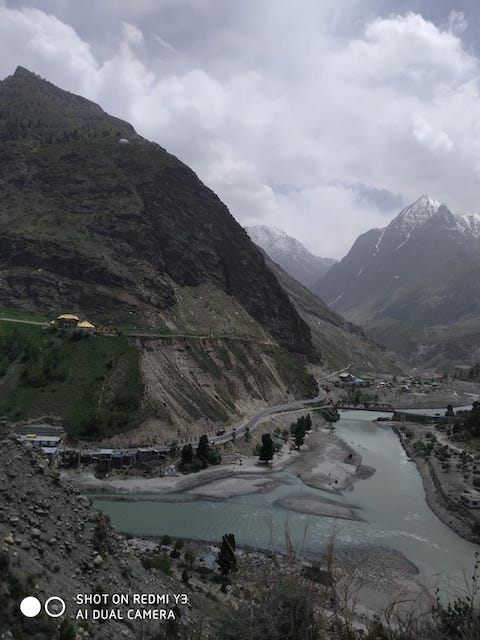Manali: In a bid to revive the Lahaul valley’s river heritage, tribal’s, NGOs, religious and cultural organizations have joined hands to celebrate the first-ever Chandra-Bhaga Sangam Parv at Tandi, the confluence of the Chandra and Bhaga rivers.
The tribal society of Lahaul seeks to preserve its river heritage with Sangam Parv and will make it an annual feature along the lines of Sindhu Darshan of the Ladakh fame, said Dr Chander Mohan Parshira, president, Sangam Parv organizing committee.
Dr Parshira said Shiv Puran mentions that Goddess Sandhya meditates at this Sangam and the marriage of sage Vashisht was ceremonies’ there. Also, Buddhist monks had meditated on the banks of the Sangam, including Lomesh Rishi and Indian sage Ghantapa of the eighth century, he added.
The Drilbu Ri mountain of Chandrabhaga is one of the most sacred pilgrimages for the Buddhists after Mount Kailash. “To establish its importance, the Dalai Lama performed a parikrama of this mountain in the mid-eighties. The monk of Hemis Gompa and the prince from Zanskar have also meditated on the mountain”, said Dr Parshira.
The sangam of Chandra River & Bhaga River river is considered as a sacred point by the local Lahaul valley residents.
Vinod Larjee of Tandi village in Lahaul said Chandra River & Bhaga River Confluence (Sangam) Chandra flows in from south east and Bhaga flows in from north east. The combined river is called Chandrabhaga and it flows to the North West. Chandrabhaga in its lower reaches is called Chenab which is a major tributary of Indus River (Sindhu Nadi). It becomes the Chenab when it joins the Marau River at Bhandera Kot, 12 kilometres from Kishtwar Town in Jammu and Kashmir.

Chandrabhaga is really born out of love. It is said that the daughter of the moon ‘Chandra’ and the son of the Sun ‘Bhaga’ fell in love and decided to take a long walk circumambulating the holy mountains of ‘Lahaul’. After many a meandering course they fell into an eternal embrace in their togetherness at ‘Tandi’ to give rise to ‘Chandrabhaga’.
According to the religious beliefs of the Hindu culture, the holy Chandrabhaga has great significance. Followers of this religion take a holy dip in the river Chandrabhaga on various occasions. The river plays an important role even after the demise of a person who follows the path of Hinduism. This is why Hindu families take the deceased bodies to the bank of the river Chandrabhaga before cremation and after the cremation, they immerse the ashes in the holy water of the river Chandrabhaga .
Different people have different considerations regarding the immersion of human ashes in the Chandrabhaga . Some of those are widely believed and accepted.
The first reason for offering the ashes to the river Chandrabhaga is, it helps the soul in leaving the physical body after demise and attain peace and salvation.
The pious water of the river Chandrabhaga refrains the departed soul from returning to the prior life. The immersion process helps the spiritual essence in cutting off from the bonds so that it can take a rebirth.
It is also believed that the holy water of the river Chandrabhaga has the divine strength to make deceased people get rid of their sins and misdeeds that they have done unintentionally in their lifespan.
Immersion of human remains or ashes in the river Chandrabhaga prevents the family members from any kind of supernatural disturbances.
People also consider the river Chandrabhaga as a gateway to heaven after the demise. The departed soul can rest in eternal peace in the heavenly abode of God.
Due to these beliefs people visit the Chandrabhaga sangam after the cremation of a deceased family member and offer the remains in the lap of Chandra Bhaga. Some people do this ritual after two or three days of the cremation while some believe that the right time of performing Asthi Visarjan is after the completion of the entire death rituals or after 13 days.
Apart from religious beliefs many scientific reasons also coerce the Hindu followers to perform the ritual of Asthi Visarjan in the sangam. Here are some strong points that support this activity.
As the Hindu religion strongly believes in the connection of rituals with scientific reasons, not a single follower of Hinduism skips the Asthi visarjan activity.

Sanjay Dutta, an engineer by qualification but is a journalist by choice.
He has worked for the premier new agency Press Trust of India and leading English daily Indian Express.
With more than a decade of experience, he has been highlighting issues related to environment, tourism and other aspects affecting mountain ecology.
Sanjay Dutta lives in a village close to Manali in Kullu valley of Himachal.



Wish this is a great success, very well covered Sanjay, keep up the good work of highlighting such important heritage and environment issues